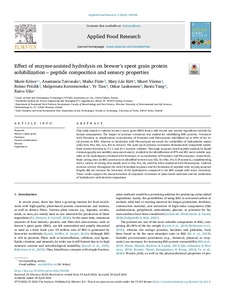Effect of enzyme‐assisted hydrolysis on brewer's spent grain protein solubilization – peptide composition and sensory properties
Taivosalo Anastassia; Yang Baoru; Viirma Maret; Laaksonen Oskar; Tian Ye; Föste Maike; Vilu Raivo; Priidik Reimo; Kütt Mary-Liis; Korzeniowska Malgorzata; Kriisa Marie
https://urn.fi/URN:NBN:fi-fe2022081153875
Tiivistelmä
This study aimed to valorize brewer's spent grain (BSG) from a side-stream into protein ingredients suitable for human consumption. The impact of protease treatments was studied for solubilizing BSG proteins. Treatment with Protamex or simultaneous co-incubation of Protamex and Flavourzyme solubilized up to 60% of the total protein in BSG, whereas co-incubation with Flavourzyme increased the availability of hydrophobic amino acids (Val, Phe, Ala, Leu, Ile) in extracts. The scale-up of protease treatments demonstrated comparable solubilized protein fractions in 0.1 L and 10 L reaction volumes. Thorough sequence-based peptide analysis by liquid chromatography-ion mobility-mass spectrometry resulted in the identification of 479 and 451 water-soluble peptides in the hydrolysates obtained with Protamex or co-incubation of Protamex and Flavourzyme, respectively. Main cutting sites on BSG proteins were identified between Leu-Gln, Tyr-Phe, Pro-X (Protamex), complementing with a variety of cutting sites mainly next to Gln, Pro, Ile, and Phe when combined with Flavourzyme. Uniform protease activity throughout the entire B-hordein sequence and the formation of peptides with varying sequence lengths did not increase the bitterness of the hydrolysates compared to the BSG sample with water extraction. These results support the characterization of enzymatic treatments in plant-based materials and the production of hydrolysates with desired composition.
Kokoelmat
- Rinnakkaistallenteet [19250]
